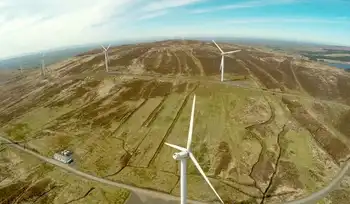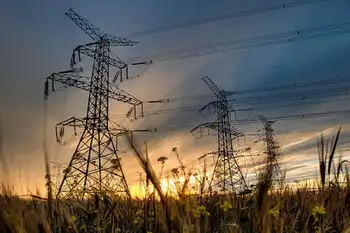Renewable winds blow in New Brunswick
The 30 1.5 megawatt wind turbines stretching across a vast 3,100-acre territory produce a combined 45 megawatts, increasing the province's total MW generation to 294 — enough power to support 45,000 homes. New Brunswick is Canada's fourth largest producer of wind energy, behind Alberta, Ontario and Quebec.
NB Power has made a concerted effort in adopting renewable energy sources. Acting under the Renewable Portfolio Standard's prescribed five per cent target by the end of the 2012 fiscal year — the target level is an indication of the volume of energy generated from a renewable source — the company has exceeded the mark significantly, forecasting a level of 30 per cent at the deadline.
According to Energy Minister Craig Leonard, the province has further surpassed the target in the realm of non-emitters.
"We already generate close to 30 per cent of our electricity from renewable sources, when you take into consideration our existing hydro and wind," said Leonard. "In fact, if you add Lepreau in there and look at it from a non-emitting generation source, we're close to seventy per cent."
Yet, in the eyes of many, the push to renewable energy is a problematic one, especially in the wind energy sector. The intermittency of wind and issues with energy storage comes under heavy scrutiny when evaluating wind's lasting quality as an alternative source of generation. High operational and maintenance costs are also called into question when considering the harsh Canadian winters. Unemployment issues, diminished property values and difficulty acquiring land in optimal areas for the massive farms are hindering the progression of wind energy. However, the claim that concerns citizens and consumers first and foremost is simply its cost-effectiveness.
A number of farms across the country have eclipsed the $100-million mark, including the new Lamèque Wind Power Project, which totaled approximately $115 million. The farm does power 8000 homes, however. Yet, some are concerned with the rising costs.
"I have no problem with wind at all, except it's expensive and that's a fact," said Jim Irving, president of J.D. Irving Ltd., in an interview with The Daily Gleaner in February after a meeting with the province's energy commission.
"Are we going to support local jobs and a local mill and local loggers, or are we going put up a wind tower?" he added in reference to potential layoffs.
The main idea behind moving to renewable sources of energy is one day they will become inexpensive, easily produced and environmentally friendly. However at the moment, economically speaking, the main stakeholders in wind power have not achieved their goal.
"We're paying 10 cents per kilowatt-hour from agreements the previous government had signed, but electricity on the open market today is around four cents," said the Energy Minister. "When energy prices fluctuate, the value and the cost-effectiveness of wind certainly moves in tandem with that."
"Everybody wants to use them and have them available to them. But when it comes to pay the power bill, everybody wants the lowest cost possible," continued Leonard. "Those two realities just don't match up in today's market where renewables are more expensive than fossil fuel generation."
The minister remains firm in his stance, however, saying moving towards renewable energy is at the top of his priority list. He did note it would not be a short or seamless transition, but hopes future developments will allow the province to harness renewable energy in a cost-effective manner.
New Brunswick has become a hotspot for wind, with a number of areas reaching a mean wind speed over 8.5 m/s, The areas include the Acadian Peninsula, Southeastern NB, the Fundy region, Grand Manan Island, the Grand Lake area and the Mount Carleton region.
The province's wind resource is exactly what drove ACCIONA Energy to Lamèque. Despite the growing concern of wind energy's cost-effectiveness, Dan DuBois, chief development officer for ACCIONA Wind Energy Canada, suggests New Brunswick has the potential for a strong renewables market because of its resources.
"In some markets, we are either at or close to parity between wind generation and other forms of generation," said DuBois. "One of the key drivers is the wind resource. The better the wind resource, obviously the lower the cost per kilowatt of the generation."
With Lamèque receiving some of the strongest gusts in the province on a regular basis, ACCIONA seems poised to see a profitable return on their new project, which in turn means economic growth in the region.
Wind power projects have the ability to be quite prosperous for a community. TransAlta, owner/operators of the Kent Hills Wind Farm 60 km south of Moncton, invested a total $28 million in the community with the recent expansion.
The current system in which the farms are constructed and operates falls under Power Purchase Agreements between NB Power and the owner/operators of the company's three wind generators: Lamèque, Kent Hills and Caribou Mountain Wind Park. There are a number of private wind farms currently active in the problems not under PPA with NB Power.
The nature of these agreements, as DuBois suggests, are favourable for consumers. The PPA arrangement is essentially a competitive solicitation, in which the lowest-cost projects are awarded.
The facility on the Acadian Peninsula marks the fourth ACCIONA farm in Canada out of their 200 worldwide. The nation's wind resource has remarkable potential and ACCIONA's actions are indicative of just that. They are currently furthering their expansion in Canada with several projects in the development stage, including in Aulac, NB.
According to the World Energy council, the global wind energy capacity doubles every three years with approximately a 30 per cent annual increase. Today, over 4,500 MW of wind is being produced in Canada, with several projects having a combined total of 700 MW constructed in 2010 alone.
A quote from the Canadian Wind Energy Association website said:
"Canada has still only scratched the surface of its massive wind energy potential, which currently powers over one million Canadian homes. Tomorrow we hope to do even more. Countries like Denmark already get over 20 per cent of their electricity from wind. If we did the same in Canada, we would have enough wind energy to power 17 million homes! As long as the wind continues to blow, there is a great future in wind energy."
The next step in continuing the progression of wind power is a divergence from fossil fuel usage — not the easiest of tasks, but one sorely needed. According to a 2008 Environment Canada study, 21.2 per cent of Canada's greenhouse gas emissions are a result of the oil, gas and coal industries.
"The volatility of fuel pricing scares us all. We see it every time we fill up our vehicles," said Scott Harper, CEO of the Wind Energy Institute of Canada.
"The opportunity to have price certainty on that supply for a 20-year period, there's a return on that. There's a benefit to that. It can become a stable part of your energy mix."
He noted the 'green movement' is not only at corporate level or in dedicated institutes across the country but at the grassroots level as well.
"There is a recognition that the majority people would prefer to do something of a more environmentally friendly nature," said Harper. "We see it in grocery stores where people are looking for organics. You see it in energy where people are looking for products deemed more environmentally friendly."
The fact remains, however, Canada's dependence on fossil fuels is a quality not easily shed. What lies ahead of Canadians is a mixed-usage of fossil fuels and renewable energy.
"Balancing that power is a huge challenge right now because we primarily balance the wind with our fossil fuels, such as Belledune, but it actually tends to negate the environmental benefit," said the Energy Minister.
"When that wind is not blowing, we have to utilize other sources and New Brunswick is, inevitably, going to be using fossil fuels because the way our system is set up now."
The solution? Powerful storage units capturing energy to ensure power levels are high during low points in wind gusts. However, according to Harper, technology as not caught up as of yet.
"The problem with storage is when you store it and you convert it back out, there's an efficiency loss in there."
Wind is already expensive in today's market and losing precious energy is not conducive to producing a cost-effective product. Until technological advancement improves the reproduction power of the units, the intermittency of wind is not solved.
The next solution in avoiding the continual over-dependency on fossil fuels? Instead of a mixed-usage with fossil fuels and renewable energy, it's a mixed-usage of renewable energy and other source of renewable energy.
"There are people who don't believe wind energy is all that it's cracked up to be, but we really believe it is an important part of a strong energy mix," said Lindsey Moen, of TransAlta. "We've never said it's a silver bullet — it's not going to be the ‘be all end all’. We don't have a single source right now that could be the ‘be all end all’. There are positives and negatives to all of them and that's why we need to keep them all working well together.
The historically coal-focused company has made recent acquisitions to improve their standing on the renewable energy front. Moen reported wind energy makes up 12 per cent of TransAlta's total generation.
The vision is similar in New Brunswick.
"We want to see more of a balanced and diversified mix in our generation and that includes the renewable portion," said Minister Leonard.
The province is currently looking at biomass as a renewable energy source to compliment their powerful wind generation in the first step of creating a strong renewable mix.
It will play an important part in eliminating the need for fossil fuels, while providing a strong economic return for investors.
Related News

Price Spikes in Ireland Fuel Concerns Over Dispatachable Power Shortages in Europe
DUBLIN - Irish grid-balancing prices soared to €3,774 ($4,284) per megawatt-hour last month amid growing concerns over dispatchable power capacity across Europe.
The price spike, triggered by an alert regarding generation losses, came only four months after Ireland and Northern Ireland launched an Integrated Single Electricity Market (ISEM) designed to make trading more competitive and improve power distribution across the island.
Evie Doherty, senior consultant for Ireland at Cornwall Insight, a U.K.-based energy consultancy, said significant price volatility was to be expected while ISEM is still settling down.
When the U.K. introduced a single market for Great Britain, called British Electricity Trading and…





